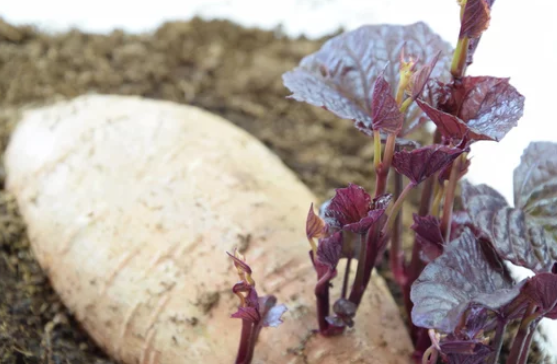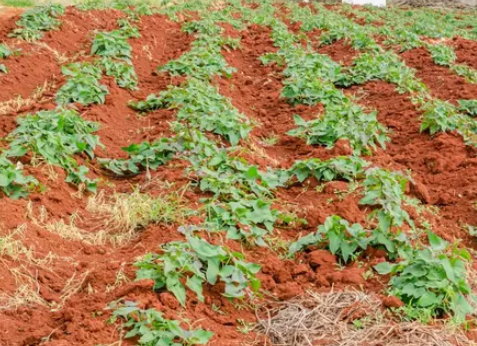A wholesome and adaptable crop, sweet potatoes can be cultivated in a variety of climates all over the world.
Although there are several ways to cultivate sweet potatoes, using slips is one of the most popular.
The sprouts or branches of a mature sweet potato are used to generate slips, which are tiny plants.
Sweet potato slips are extremely straightforward to plant and only require a few uncomplicated steps. This guide will take you step-by-step through the planting of sweet potato slips, from picking the best sweet potato to reaping the harvest.

Step 1: Choose the Right Sweet Potato
The first step in planting sweet potato slips is to select the right sweet potato. Look for a mature sweet potato that is firm and free of blemishes or cracks.
It is best to use a locally grown sweet potato, as they are more likely to be well-suited to your climate and soil conditions. If you are not sure which variety of sweet potato to use, ask your local agricultural extension office for recommendations.
Step 2: Prepare the Sweet Potato

Once you have selected a sweet potato, you will need to prepare it for planting. To do this, place the sweet potato in a warm, humid location, such as a greenhouse or covered porch.
Leave the sweet potato in this location for several weeks, until it begins to sprout.
You can also speed up the sprouting process by placing the sweet potato in a warm, moist environment and covering it with a clear plastic bag.
Step 3: Harvest the Slips

Once the sweet potato has sprouted, you can harvest the slips. To do this, carefully remove the sprouts or shoots from the sweet potato.
Be sure to use a sharp knife or scissors to avoid damaging the slips. Each slip should be at least 6 inches long and should have several leaves.
Step 4: Prepare the Planting Area
Before planting your sweet potato slips, you will need to prepare the planting area. Sweet potatoes prefer well-draining soil that is rich in organic matter.
To prepare the soil, remove any weeds or rocks from the area and add compost or well-rotted manure. Till the soil to a depth of at least 8 inches to ensure that it is loose and crumbly.
Step 5: Plant the Slips
Once the soil is prepared, you can plant the sweet potato slips.
To do this, make small holes in the soil, each about 6 inches deep. Place each slip in a hole and cover it with soil, leaving the top leaves exposed.
Space the slips about 12 inches apart to allow room for the vines to spread out. If you are planting in rows, space the rows about 3 feet apart.
Step 6: Water and Fertilize

After planting your sweet potato slips, it is important to water them thoroughly.
Sweet potatoes need regular moisture to thrive, so be sure to water them deeply at least once a week. It is also important to fertilize your sweet potato plants regularly.
Use a balanced fertilizer that is high in potassium, as this will help promote root growth and the development of large, healthy sweet potatoes.
Step 7: Control Weeds
As your sweet potato plants grow, it is important to control weeds.
Weeds can compete with sweet potatoes for nutrients and moisture, which can reduce the yield of your crop.
To control weeds, use a hoe or cultivator to gently loosen the soil around your sweet potato plants.
Be careful not to damage the plants, and be sure to remove any weeds that you find.
Step 8: Harvest Your Sweet Potatoes
After about 100 to 140 days, your sweet potatoes will be ready to harvest. To do this, carefully dig up
the sweet potatoes with a garden fork or shovel, being careful not to damage the roots or tubers.
You can also wait for the foliage to die back before harvesting, as this is a sign that the sweet potatoes are mature.
Once you have harvested your sweet potatoes, store them in a cool, dry place for several weeks to allow the skins to cure.
Conclusion
Planting sweet potato slips is a simple and rewarding process that can yield a bountiful crop of nutritious and delicious sweet potatoes.
With these eight steps, you can ensure that your sweet potato plants grow strong and healthy and that your harvest is abundant.
Remember to choose the right sweet potato, prepare the planting area, and care for your plants with regular watering, fertilizing, and weeding.
With a little patience and attention, you can enjoy the many benefits of growing your own sweet potatoes
Reference
Here are some sources I used in writing this post you can get more info here:
- “Growing Sweet Potatoes,” University of Georgia Extension, https://extension.uga.edu/publications/detail.html?number=B1314
- “Growing Sweet Potatoes,” North Carolina State University Extension, https://content.ces.ncsu.edu/growing-sweet-potatoes


